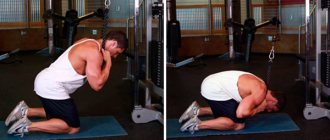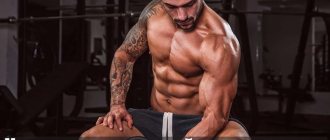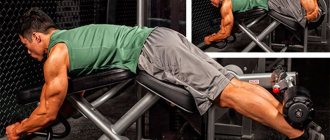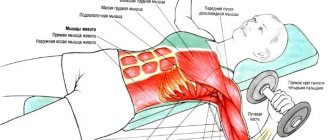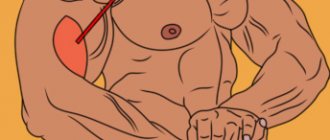Standing hammers are a common exercise for working the biceps. It is accessible to all levels of practitioners and can be performed with minimal equipment. It suits most people. But the problem is that many perform it with technical errors, throwing the dumbbells to their shoulders by the force of inertia, or making too many unnecessary movements. This is what keeps people away from building the most impressive biceps, and not the wrong choice of exercise. Fortunately, anyone can learn to make hammers; it's quite easy.
Execution technique
Initial position
- Choose a pair of dumbbells for warming up and for working sets. There is no point in giving any general recommendations here. According to the rules, the last two repetitions should be given hard, at the limit of strength. The weight is selected independently, based on this;
- Next, you need to take dumbbells in your hands with a neutral grip, palms facing each other, body vertical, spine neutral, you need a fairly well-tight stomach and collected shoulder blades;
- The forearms are pressed to the body, the position of the body is regulated by stabilizers, you cannot swing.
Movement
- From the stretched position, the dumbbells are brought to the shoulders by bending the elbows;
- The biceps works as the main mover and drives the dumbbells to the shoulders;
- You should stop at the point of maximum tension; you should not bring the dumbbells to your shoulders above this point, this does not lead to a better result;
- You can do the bends one at a time, or simultaneously. In the first option, attention is better concentrated on the work of the biceps, so most athletes are suitable for the alternating flexion option;
- Bending is done while exhaling, lowering while inhaling;
- You need to work smoothly and slowly until all repetitions are completed, the lifts are adjusted to the normal pace of breathing, and not vice versa.
It's "THE HAMMER", baby.
Attention
- Your elbows should be approximately in the plane of your spine. They do not need to be pulled back, reducing the amplitude of lifting and making movement easier. If this is the only way, you need to take lighter dumbbells;
- Bringing the elbows forward loads more of the forearm and also reduces the amplitude. This is a mistake;
- Swinging the body and throwing dumbbells due to the force of inertia is not allowed;
- It is better to refrain from fully straightening your arms at the lowest point of the amplitude. This can lead to overload of the elbow ligaments.
Recommendations
- Keeping your hands in the same plane, the dumbbell bars rise along two parallel elliptical paths. Otherwise, the turn will disrupt the lifting mechanics and lead to a technical error;
- Don't lift too quickly as you don't want to bounce the dumbbells off your forearms and lose muscle tension. In this exercise, it is important to always tense your biceps and not relax them at the lowest point.
Technique for performing hammer curls for biceps
The “Hammer” exercise is varied: it can be done by changing the starting position and using different types of equipment.
Before starting the exercise, you should warm up the elbow joint well, as it is the only joint that takes on the load in this exercise. It is recommended to perform a series of rotational movements in the elbows with fixed shoulders. The first approach should be done with a light weight for 12-15 repetitions.
Standing two-arm raises
Standing on the floor with your feet shoulder-width apart, you need to fix the natural arch in your lower back and not change this position until the final repetition is completed. The starting position must be stable. Take dumbbells with a neutral grip.
- After inhaling, they begin to raise their arms, bending them at the elbow joints. The moment of maximum muscle effort is done while exhaling.
- At the top point, the dumbbells rise almost to shoulder level. Here it is important to feel the peak muscle contraction and take a short break.
- With a controlled and slow movement, lower the weight to the starting position, preventing the arms from swinging back: on the next lift, this will turn on the inertial force, making it easier for the target muscles to work.
Perform 8–12 repetitions in 3–4 sets.
sma
Peak contraction of the biceps occurs before the hand touches the shoulder (approximately ¾ of the way up). Therefore, at the top point, you should not bring your forearms to a vertical position: the biceps muscle will get a break, and the weight will be supported by the force of the joints and tendons.
Up and down movements are performed without jerking or swinging the body. Flexion and extension occur only in the elbow joints.
To make it easier to control a stable position, you can do hammers while standing against a wall, touching it in the area of the buttocks and shoulder girdle.
Before performing the exercise, you need to familiarize yourself with some of the nuances that are presented in the video.
Video: Technical nuances of hammer lifts
Alternate raises with each hand while standing
Many athletes who have included hammer curls in their training program practice just this version of the exercise. It takes twice as long to complete, but partial restoration of muscle energy resources allows you to work with a greater load.
When starting to perform the hammer in alternate mode, they take the starting position, similar to the classic standing lifts.
- After a deep breath, they begin to lift one of the dumbbells towards the delta, bending the working arm at the elbow joint. The second hand at this time holds the weight and is directed vertically downward.
- When the hand reaches the top of the chest, you should pause for 1-2 counts, tensing the target muscles as much as possible.
- As you inhale, lower the dumbbell to the bottom position. This movement is done smoothly, slowly and under control.
- Next, similar actions are performed with the other hand. This completes the first repetition.
Perform 8–12 repetitions in 3–4 approaches.
emergency
Alternate dumbbell bends with a neutral grip can be done in another version: having taken the starting position discussed above, first do the required number of repetitions with one hand, then with the other. At the same time, both the working and free hand hold the weight: this helps maintain a stable position of the body.
In alternating bends, it is important to avoid swaying from side to side when performing movements.
Working with each hand separately, you can experiment with the trajectory of the dumbbell, changing it from vertical to diagonal (the projectile rises in front of the chest). This will shift the working emphasis to the shoulder muscles. The elbow of the working arm should not go to the side.
With
Raises while sitting on a bench
Working out the arms with hammer curls, performed while sitting, is an excellent option for beginners and those with problematic backs. This option puts less strain on the spine and stabilizes the body well. This makes it possible to concentrate on contracting the target muscles without being distracted by monitoring the work of stabilizer muscles.
The “hammer” in a sitting position minimizes the possibility of cheating, so the exercise in this version is easier to perform technically purely.
The hammer curl technique while sitting on a bench is similar to training in a standing position. You can perform alternating movements with your left and right hands, as well as with both hands at the same time.
va
Scott Hammer Raises
Almost every gym has a special design designed for working out the arms, called a Scott bench. If you perform the “Hammer” exercise on it, the movements will be cleaner from a technical point of view due to the fixed position of the elbows.
- After adjusting the height of the music stand and taking dumbbells in your hands, place them on the seat.
- You need to rest your elbows on the stand, and turn your palms holding the weight towards each other.
- Straightening your arms, slowly lower the dumbbells (a feeling of stretching should appear in the muscles).
- Following a deep breath, holding the breath for a short time, begin lifting the dumbbells towards the shoulders. In this case, the triceps should not come off the music stand. The most difficult part of the trajectory coincides with exhalation.
- In the top position, make a second stop, tensing the target muscles as much as possible.
- Smoothly and under control lower the dumbbells onto the stand and repeat the upward movement.
Perform 8–12 repetitions in 3–4 approaches.
m
On the Scott bench, you can do alternate bendings, and also work out first one and then the other arm in the required number of repetitions.
Video: hammer curls on the Scott bench
Exercise "Hammer" on a block simulator
Hammer style lifts can be performed on a pulley machine using a rope handle. Having connected it to the lower lever, stand facing the device at a distance of about 30 cm. Holding the handle with a neutral grip, press your elbows to your body. There is a natural arch in the back.
- As you exhale, raise your arms, bending them at the elbow joints, almost until your biceps touch your forearms.
- After a second delay they return to the starting position. In the lower position, the arms are fully extended, but not taken back.
Do 10–15 repetitions in 3–4 sets.
to you
Execution options
Simultaneous bending of both arms using the hammer technique
This version of the exercise is suitable for those who have been training for a long time. It is more extensive than regular dumbbell curls, so may not be suitable for beginners. This option is good for those who can hold their hands fairly straight, in one plane, and lift dumbbells without tilting them to one side. This variation can be performed with heavier dumbbells and be the first or main exercise in a biceps workout. Alternating lifts usually complete the workout and are performed with lighter weights.
Hammer Front Raise
This is a kind of biceps curl, as if obliquely, the dumbbell goes to the opposite shoulder along an elliptical path in front of the body. The biceps curl in front of the chest involves the shoulders to a greater extent in the exercise. This option is loved by “mass monsters”, as it is technically more convenient for large hands, but you need to remember about balance and the need to isolate the working muscle group.
Con
The exercise is performed on a Scott bench, or with your elbow on your thigh in a sitting position. The hammers become “concentrated” when the elbow is placed on an incline bench and the arm is bent through its full range of motion. In this option, you take less weight, cheating with the body will not work even if you want to, the exercise is performed quite carefully and in a limited amplitude;
Hammers on an incline or Scott bench
In gyms where there is no Larry Scott bench, the exercise is performed on a regular “incline.” The forearm is placed on a bench inclined at an angle of 30 degrees, and the movement is performed with the arm fixed. In halls where there is a Scott bench, you can use it. This type of exercise is more isolated, it is good because you can work your arms with less weight, and also do not involve the body at the same time.
"HAMMER" Exercise for HUGE biceps!!! Kock technique!) VOD
Technique for lifting dumbbells with this grip
The hammer exercise for biceps with dumbbells is performed as follows:
- take the shells in each hand, the palm should face the body, the thumb in front;
- the back should be straight, bending is not allowed, so as not to injure the lower back, you should not tilt your back forward or backward either;
- Without allowing your body to oscillate, lift the dumbbell up, bending your arm at the elbow. Throughout the entire exercise, the back should be straight, otherwise there will be additional stress on the spine, which is best avoided, especially if there are injuries or diseases;
- At the top point, hold the projectile a little, then slowly lower it to the starting position. The average delay time should be about two seconds. If this does not work, it is recommended to slightly reduce the working weight of the dumbbell;
- do the same with the second hand.
Attention! The “hammer” allows you to work not only the long biceps muscle, but also the brachialis, which is located closer to the forearm, on the outside. The development of the brachialis “pushes out” the biceps, making it visually wider.
When performing hammer dumbbell raises, it is recommended to follow some guidelines:
- the upper part of the arm should remain motionless, movements are carried out only by bending the elbow;
- The torso should also be fixed, the back should be straight. Body movements forward and backward, as well as bending, are not allowed. If you use a special bench, you can set the back as straight as possible and lean on it;
- the hands should not turn, the palms should be directed towards each other throughout the entire exercise;
- lifting two dumbbells at once is allowed, but for beginners it is better to do it one by one until the technique is mastered.
Doing the exercise incorrectly will shift the load to other muscles, which is not recommended. The point of performing a “hammer” is precisely to pump up certain muscles, which is only possible with the correct technique.
Take the projectile correctly
Proper hold of the projectile is the basis of the technique. The dumbbell should be taken with the hand in the middle of the handle, with the arms along the body, palms facing each other.
When performing the exercise, the palms should not change their direction. Twisting or turning is not allowed.
Execution options
Lifting dumbbells for biceps with a hammer grip can be done both standing and sitting. The main differences between the two options are precisely the initial position of the body. The emphasis of the load does not fundamentally shift, so both options are acceptable; the issue is more about convenience.
The standing hammer exercise is performed as follows:
- stand straight, back without bending or bending, with a dumbbell in each hand;
- hands, palms facing each other, clasp the dumbbells in the middle of the bar;
- Without changing the position of the upper arm, bend it at the elbow to approximately chest level;
- hold this position for a couple of seconds, then slowly lower your hand down.
The sitting exercise is performed in exactly the same way, the back will be straight, the arms move only at the elbows, the upper part remains motionless. It is better to sit on a bench or chair that is not too high, so that nothing interferes with the movements of your arms.
Interesting! Using a bench with the ability to change the angle of the backrest will help to slightly change the nature of the load and complicate the movement. At the beginning, you can install it as straight as possible, then increase the load by tilting it back. If the angle is about 45 degrees, the movement will become much more difficult, it is worth using less working weight.
Analysis of the exercise
What muscles work
- The main movers are the biceps and brachialis;
- How stabilizers work the brachyradialis, shoulders (anterior deltoid), core muscles, if we work while standing, and even the abs
pros
- This movement is often used to develop the ability to pull heavy weights while bending over on your back. It prepares the elbows and forearms for stress, allowing you to develop not only strength, but also endurance of small muscles;
- The exercise allows you to get rid of problems with insufficient development of one half of the body; it helps to create a symmetrical physique;
- A fairly simple technical movement suitable for beginners;
- Can be performed with the simplest equipment;
- The exercise is done at the end of the workout; it can be performed with light weight to avoid overstretching the ligaments of the elbow joints;
- The movement is suitable for beginners;
- Allows you to increase the total weight of your arms
Cons of the exercise
- Trainers often remove movements from more advanced amateurs' programs so that they can develop their biceps more harmoniously with higher isolation exercises. This movement, as it were, “blurs” the load between the biceps, brachialis, and muscles working statically. Many people don't like it;
Description of the exercise
By holding your arm this way, you put more stress on the inner head of the biceps and forearm. Quite a simple and effective exercise. Watch your elbows. They should not “dance” either to the side or too far forward.
You can do it both simultaneously and alternately. Both sitting and standing. I still advise beginners to do it alternately. Then you will sway less. The hammer exercise is not suitable as a basic exercise. It’s good to do it at the end of an arm workout. To completely hammer not only the biceps, but also the forearms.
Main features
1. Do not lift the dumbbell to your shoulder (as if throwing it up). The biceps at the top of the trajectory should be as tense as possible. And when throwing, the load is removed from him and he relaxes.
2. Don't swing your body. This especially happens by itself if you do it alternately. When swinging, you lift the dumbbells by inertia, and not by the strength of your arm muscles. Therefore, the effectiveness of the exercise decreases.
3. This exercise is not basic. Therefore, there is no point in taking too much weight and somehow doing 5–6 repetitions. The weight should be such that you can do at least 8 clean and beautiful repetitions.
4. At the bottom point, straighten your arms to the end, relaxing your biceps. This way you can do more repetitions. But you don’t need to move your hand back to avoid swinging.
5. When sitting on a bench, it is better to do this with support on the back. This way you won't sway. In addition, you can complicate the exercise if you place the backrest not vertically, but slightly at an angle.
Preparation
Preparing for this movement is quite simple. It is not put at the beginning of the workout, so the joint warm-up is performed generally at the beginning; there is no need to do any special warm-up before bending with hammers. Typically, the “warm-up” is horizontal rows for the back, or other exercises for this muscle group. It is best to do the exercises so that it is not the first one in the plan, and then there will be no need for any kind of joint warm-up.
Before working approaches, a movement with light weight is performed in a number of repetitions of about 15-20 in order to fill the working muscles with blood and additionally engage the neuromuscular connections.
Proper execution
- Lifts are carried out while exhaling, the pace is quite slow, muscle contraction is concentrated. You should not bring the dumbbells up to your shoulders and keep them in this “empty zone”;
- Cheating and body swinging are not allowed in all movement variants;
- Hammers with a neutral grip are considered a universal movement that engages not only the biceps and brachialis, but also the brachyradialis. The distribution depends on the grip. If the palms are directed towards each other, the biceps work more; when turning with the palm down, the brachialis and brachioradialis muscles work;
- Elbows should be kept motionless and pressed to the body. They are not moved forward, backward or shifted in different directions;
- The exercise is performed with a relatively limited amplitude; you should not fully straighten your elbows and lift the dumbbells into a “dead hang.” As soon as the load on the biceps decreases, the trajectory should be shortened;
- It is not entirely correct to do this movement in “cardio mode,” that is, performing multiple swings of dumbbells in a large volume. It is better to do it quite concentrated and slowly to achieve maximum elaboration.
Errors
- The main technical mistake is “relaxing” the hands with dumbbells and lowering the apparatus along the body too quickly, so that they fall by inertia without the participation of muscles;
- There is no need to lift the weight by pushing with your legs and body;
- You should avoid bringing the dumbbells close to your shoulders;
- You cannot move your elbows away from the body in different directions.
Efficiency Tips
- The best way to perform this movement is to choose the weight so that it is optimal, does not overload the elbows, and does not force you to do hammers due to cheating;
- Beginners should start not with standing hammers, but with performing the exercise while sitting, in order to make the exercise certainly isolated;
- If the elbows diverge and move away from the body, it makes sense to lean your back against the wall, or stand with your spine close to any vertical support;
- At the top point you need to statically tense your muscles and stop
Standing dumbbell curl. Hammer grip #DarkFit
Features of the exercise
The main features of the exercise are as follows: the more our palm is turned towards the floor, the more the shoulder muscle is involved in the work. And vice versa, the more the palm is turned upward, the better the biceps itself works. When choosing a middle position (with your palms parallel), the movement becomes more basic. That is, it uses more muscles, which allows us to lift larger weights. However, in this case, targeted training of each individual muscle does not occur, so the emphasis shifts from one muscle to several.
To summarize:
- A reverse grip, palms down, is a big load for the shoulder muscle.
- Palms facing up - load directly on the biceps.
- Medium grip, palms parallel - the load is distributed.
Inclusion in the program
The movement may be the only biceps exercise in benchers' and powerlifters' programs. In bodybuilding and fitness, it is most often used as a “second” exercise along with barbell curls.
There may be other inclusion options. For example, hammers precede barbell curls so that a person can warm up properly.
Seto-repetition schemes can be different. Perform 8-12 repetitions or 15-20, depending on the weight and goal. In pumping mode, muscles are worked with less weight and a higher number of repetitions.
Hammer exercise with dumbbells: what muscles are involved, options and specifics of execution
The “hammer” (or “hammers”) exercise with dumbbells is an isolated, that is, a single-joint exercise, during which only the elbow joint is involved. For some reason, some “experts” call the biceps hammer curl basic training, which is fundamentally wrong and even stupid.
“Hammers” with dumbbells are designed for specific training of the biceps brachii muscle (biceps) with an emphasis on its outer (long) bundle and a number of shoulder muscles that directly affect the volume and strength of the biceps. In general, the anatomical atlas of the biceps hammer exercise looks like this:
- external biceps bundle (the internal one is practically not involved);
- brachialis muscle (brachialis);
- brachioradialis muscle (brachioradialis).
All these muscles are target muscles, that is, we are working on them. To an indirect extent, depending on the version of the biceps hammer exercise, other muscles can be involved:
- anterior deltoids;
- coracobrachialis muscle;
- upper part of the pectoral muscles;
- trapezius muscles;
- a number of muscles of the forearm.
Please note that when performing the biceps hammer correctly, the pronator teres is not involved! The wrist and forearm remain in a static position throughout the training. If we add supination (outward rotation of the wrist), then we are no longer talking about “hammers” with dumbbells, but about the classic biceps curl with supination (we devoted a separate article to this exercise).
“Hammers” for the biceps (video below) can be performed in various variations, while the load will somehow shift from the target muscles and involve additional muscles, which is not always advisable. Indeed, from the point of view of biomechanics, we work directly on the outer part of the biceps, as well as the brachialis and brachioradialis muscles, and the latter do not receive such an accentuated load in any other exercise. As a result, the biceps acquires outstanding volume and relief, and the forearm and the volume of the arm as a whole also increase.
The classic version is considered to be in a standing position, without supination. This training allows you to clearly work the target muscles, additionally using a number of stabilizers. However, dumbbell hammer curls can be performed in different ways:
- In a sitting position, leaning against the back of a bench (does not allow you to cheat by leaning your torso back).
- On an incline bench, standing with emphasis on your chest or sitting on a Scott bench (does not allow you to cheat by swinging your body).
- Sitting on a horizontal bench without a back (a slightly more complex option that also allows you to include your shoulders in the work).
- Training with support on the knee or on a table (allows you to clearly concentrate on the target muscles, but is not very convenient, and therefore almost never occurs).
- “Pigtail” in a block simulator (does not have any functional differences from the classic version).
It is worth repeating that the “hammer” in a standing position is considered traditional, and the option of sitting on a bench with your back leaning is also widespread. All other types of hammer-type dumbbell curls for biceps are less convenient and have no conceptual value for beginners and advanced athletes; they are used only by high-class professionals in a number of specific cases. Summarizing all of the above, we can safely say that the biceps hammer lift gives the following effects:
- high-quality development of the external bundle of the biceps muscle;
- accentuated work on the brachialis and brachioradialis muscles;
- qualitative increase in the volume of the biceps, forearm and arm as a whole;
- increase in strength indicators of the biceps and forearm muscles.
It is also worth noting that this type of training is quite simple in terms of technique. “Hammers” for the biceps (video at the end of the article) do not put additional stress on the wrists (as when lifting with supination), which reduces the risk of injury. That is why this exercise is optimal for everyone, including beginner powerlifters and bodybuilders.
The biceps hammer technique seems simple, and it really is. But, as with any other exercise, failure to follow safety rules and guidelines leads to decreased effectiveness and increased risk of injury. The basic and only correct technique of “hammers” with dumbbells looks like this:
- The athlete takes dumbbells of the required weight in both hands, grasping them with a standard closed grip, and stands in front of the mirror.
- Feet are positioned shoulder-width apart (or wider - the main thing is to be comfortable), look straight ahead, shoulders back, back straight.
- Palms clenched into fists are directed towards the body. Throughout the exercise, the wrists do not change their position, and the elbows and shoulders also remain in a static position.
- The athlete begins to bend one of the arms at the elbow joint, lifting the dumbbell in front of him. The dumbbell can move along any trajectory - in the same plane with the shoulder or along the body, it doesn’t matter.
- Once the arm has reached the peak point where the athlete can no longer bend the elbow or will have to change the position of the wrist to do so, he stops the movement and smoothly returns the dumbbell to the starting position.
- Then the second hand follows the same algorithm. The alternating option is considered optimal, simultaneous lifting is also acceptable, but with large weights this is quite difficult.
This is the technique of “hammers” with dumbbells while standing. Any other type of this training (sitting on a straight or incline bench, with support on the knee, with support on the chest or in a block machine) has no conceptual differences - the dumbbells move along the same path, the wrists do not rotate, the elbows and shoulders are static, in motion only forearm.
Now you know how to do “hammers” for biceps correctly (a video for a better understanding of the technique is presented below), this is a basic algorithm, violating which is impractical and unsafe. But to ensure maximum efficiency and avoid injury, pay attention to the following tips and most common mistakes:
- The “hammer” exercise with dumbbells should not be the first in the training complex for this target group. This is usually the third or fourth exercise, sometimes done in a set along with the classic biceps curl.
- Since “hammers” are an isolated exercise that follows a number of basic exercises (in the case of biceps, conditionally basic exercises), there is no need for warm-up approaches.
- Do not “chase” heavy weights, especially in the first months of training. This almost always leads to a violation of the execution technique, the training becomes ineffective and you can get injured.
- Always remember that only the forearm moves. The elbow, shoulder and wrist are immobile. But which vector the forearm moves in has no functional significance, do it as you feel comfortable.
- A sports apparatus always travels through the maximum possible amplitude from the starting position to the peak point; work with a short amplitude is ineffective.
- Do not change your grip during the training process, as you took the sports equipment initially - and keep it until the last repetition in the approach.
- When performing hammer curls for biceps, cheating is unacceptable! Do not lean forward or backward, do not help yourself with other muscles, do not create pushes or other impulse movements.
- Do not “throw” the sports equipment too high, otherwise you will inevitably shift the position of your elbow, which should not happen.
- Hammer lifts should be performed at a moderate pace, without unnecessary pauses, but not too quickly. Remember that one of the key factors in any training is the time that the muscles are under load.
Taking into account all these nuances, you will be able to correctly and most effectively do the “hammer” exercise for biceps, qualitatively developing the volume of your arms without the risk of injury. But if you still have any questions, you can always ask them in the comments to this article, and the Silver medalist of the World Powerlifting Championship Elite of Russia Evgeniy Volosky will definitely answer you. Be healthy, and don’t forget that any workout has only one objective assessment - the result!
We recommend reading:
- Buckwheat diet - principles of menu design
- Program for pectoral muscles - algorithm and guidelines
- Lifting dumbbells in front of you - options and technique
- Plie squats with a dumbbell - technique and biomechanics
- Exercise program for weight loss at home


